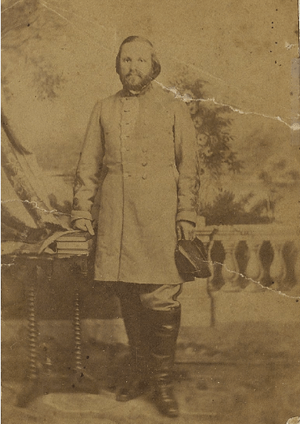Henry Marchmore Shaw facts for kids
Quick facts for kids
Henry Muchmore Shaw
|
|
|---|---|
 |
|
| Personal details | |
| Born | November 20, 1819 Newport, Rhode Island |
| Died | February 1, 1864 (aged 44) Batchelder's Creek, North Carolina |
| Resting place | Shaw Family Cemetery Shawboro, North Carolina |
| Nationality | American |
| Military service | |
| Allegiance | |
| Branch/service | |
| Years of service | 1861-1864 |
| Rank | |
| Unit | 8th Regiment, North Carolina Troops |
| Battles/wars | American Civil War |
Henry Muchmore Shaw (born November 20, 1819 – died February 1, 1864) was an important figure in American history. He served as a Representative for North Carolina in the U.S. Congress. Later, he became an officer in the Confederate States Army during the American Civil War. Sadly, he was killed in battle, becoming one of the few former U.S. Congressmen to die during the war.
Contents
Early Life and Education
Henry M. Shaw was born in Newport, Rhode Island, on November 20, 1819. His parents were John Allen and Elizabeth Muchmore Shaw. His father was a silversmith who also traded goods with the West Indies.
His family moved to North Carolina after his father lost many ships and much of his money during the War of 1812. Henry's mother passed away in 1829. His younger brother, Silas, went back to Newport to live with relatives. Henry stayed in North Carolina with his father.
Henry finished his early studies and then went to the medical school at the University of Pennsylvania in Philadelphia. He graduated in 1838. After that, he started his medical practice in Indiantown, North Carolina.
Serving in Congress
Henry Shaw was elected to the U.S. Congress as a Democrat. He served in the Thirty-third Congress from March 4, 1853, to March 3, 1855. He tried to be re-elected but did not win.
However, he was elected again to the Thirty-fifth Congress. He served from March 4, 1857, to March 3, 1859. He was not successful when he tried to be re-elected for a third time.
In April 1858, Henry debated "The Kansas Question," which was a big topic about whether Kansas should allow slavery. Henry was a strong supporter of states leaving the Union (called a secessionist). He wanted North Carolina to leave the Union even before Abraham Lincoln was elected president in 1860.
On May 21, 1861, Henry Shaw signed the North Carolina Ordinance of Secession. This document officially declared that North Carolina was leaving the United States. He used a special quill pen he made himself for this important event. This pen is now on display at the North Carolina Museum of History in Raleigh.
Role in the Civil War
When the American Civil War began, Henry Shaw joined the Confederate States Army. He was made a colonel and led Confederate forces.
Battle of Roanoke Island
Colonel Shaw was in charge of the Confederate soldiers at the Battle of Roanoke Island. In January 1862, Union forces led by General Ambrose Burnside began to arrive. They had about sixty ships and more than 13,000 soldiers. Many of these soldiers were from Rhode Island, Henry's home state.
On February 6, 1862, Burnside's forces entered Roanoke Harbor. Two days later, on February 8, Union soldiers landed on the south end of Roanoke Island. They moved north towards the main Confederate defenses. The Confederates had a three-gun battery (a group of cannons) and about 1,000 soldiers. These soldiers were not well-armed.
Colonel Shaw and his men fought bravely. But they were greatly outnumbered by the Union forces, who had five times as many soldiers. To prevent his men from being killed, Colonel Shaw surrendered.
Even though the Battle of Roanoke Island was a smaller battle, it was very important. Before this battle, the Union had not won many victories. This win helped increase support for the war in the Northern states.
Later Service and Death
After being captured, Colonel Shaw was released. The North Carolina Eighth Regiment was reorganized in the fall of 1862. Colonel Shaw took command again. He led his troops in battles in Charleston, Wilmington, and in the trenches of Petersburg, Virginia.
On February 1, 1864, in the early morning, Colonel Shaw was preparing for an expedition at Batchelder's Creek. He was shot from his horse. The bullet hit his cheek and went through his head, killing him instantly. His body was brought back and buried in the cemetery at Shawboro, North Carolina. The town of Shawboro was named in his honor.
Images for kids


